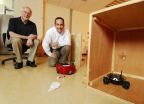(Press-News.org) URBANA – In the search for the perfect crop for biofuel production, Miscanthus has become the darling to many. But in an effort to not be charmed by its enormous potential for biomass production, researchers at the University of Illinois are taking a careful look at the pros and cons of its behavior in the field.
A recent study analyzed water quantity and quality in plots of Miscanthus, switchgrass, corn, and soybeans and found that Miscanthus used substantially more water, but reduced the potential for nitrogen pollution to water bodies.
"We found that Miscanthus tends to dry out the soil much more than corn, soybeans, or switchgrass later in the growing season," said Greg McIsaac, environmental scientist in the College of Agricultural, Consumer and Environmental Sciences. "This would likely reduce runoff, stream flow and surface water supplies later in the summer and in early fall, when streams are typically at their lowest. It could reduce the amount of water available to those who are downstream in late summer and early fall."
Switchgrass behaves like Miscanthus early in the growing season, drying out the soil. It then goes into a reproductive mode and uses very little water in the late summer and fall.
McIsaac said that Miscanthus's impact on water supply may be small if it is planted on only a few acres in a watershed. "The severity of the impacts will likely vary depending on the nature of the soils and climatic conditions. In areas where water is in short supply, switchgrass may be preferable, understanding that switchgrass creates much less biomass than Miscanthus," he said.
"It will likely be in the farmer's economic interest to plant the most productive crop, which may also use more water than their current crops. When and where this occurs over significant areas, downstream water users should consider how it is going to influence their water supply. They may need to develop plans to address more frequent water shortages, or perhaps attempt to influence the planting decisions through incentives or policy. It is something to be aware of and plan for if Miscanthus or a similar water-demanding crop becomes economically attractive to farmers," he added.
The fact that both Miscanthus and switchgrass use more water early in the growing season than corn and soybeans could be seen as a benefit because flooding is often a problem that time of year. Drying out the soil earlier in the spring would reduce runoff from spring rains, he said, and thus reduce flood flows.
The study also looked at how nitrogen moves or "leaches" into the ground water beneath the four crops. With corn and soybeans where the field has tile drainage, the fertilizer and soil organic nitrogen gets converted to nitrate which is highly soluble and moves with the water to the tile drains. From there it moves out to the ditches and streams, causing problems for drinking water supplies and contributing to the hypoxia in the Gulf of Mexico.
The Miscanthus and switchgrass plots in the study received no added fertilizer and grew vigorously without it. Consequently, it wasn't surprising that the unfertilized Miscanthus and switchgrass had much lower leaching than soybeans or fertilized corn.
McIsaac explained that there are several factors at work, not just the absence of applied fertilizers. "The roots in perennial grasses go deeper into the soil. They're more extensive and they are active earlier in the growing season – so if we had perennial corn, it might behave more like these grasses. But even with soybeans, where we also didn't apply fertilizer, the amount of leaching was almost as high as with corn. So it's not just the absence of fertilizer, it's also the perennial roots that retain more soil nitrogen."
"We did not apply fertilizer to Miscanthus or switchgrass because the study was designed to look at a low-input biofuel," McIsaac said. "The results showed that you can get high productivity without fertilizing Miscanthus, at least for the first three to four years. It is likely that if you apply fertilizer to Miscanthus and switchgrass, there would be more leaching than what we saw in our study, with no application. But because of the root activity, I would expect fertilized Miscanthus and switchgrass to leach less than fertilized corn. To be certain, this needs further study."
INFORMATION:
Miscanthus and Switchgrass Production in Central Illinois: Impacts on Hydrology and Inorganic Nitrogen Leaching appears in the September-October edition of the Journal of Environmental Quality. Authors in addition to McIsaac are Mark B. David, and Corey A. Mitchell. Funding for this research was provided by the C-FAR Strategic Research Initiative.
The pros and cons of Miscanthus -- uses more water, leaches less nitrogen
2010-09-09
ELSE PRESS RELEASES FROM THIS DATE:
Researchers give robots the capability for deceptive behavior
2010-09-09
A robot deceives an enemy soldier by creating a false trail and hiding so that it will not be caught. While this sounds like a scene from one of the Terminator movies, it's actually the scenario of an experiment conducted by researchers at the Georgia Institute of Technology as part of what is believed to be the first detailed examination of robot deception.
"We have developed algorithms that allow a robot to determine whether it should deceive a human or other intelligent machine and we have designed techniques that help the robot select the best deceptive strategy to ...
Overweight and obese make up majority in Ontario
2010-09-09
OTTAWA – September 9, 2010 --- New analysis of a landmark health survey by the University of Ottawa Heart Institute (UOHI) shows that 70% of Ontario adults are either overweight or obese, and have a strong prevalence of high blood pressure that could lead to heart attack or stroke.
The research, led by Dr. Frans Leenen of the Heart Institute's Hypertension Unit, adds new information to a limited amount of Canadian data on obesity and high blood pressure. The analysis further strengthens the link between high blood pressure and above normal Body Mass Index (BMI), a formula ...
People learn new information more effectively when brain activity is consistent, research shows
2010-09-09
AUSTIN, Texas—People are more likely to remember specific information such as faces or words if the pattern of activity in their brain is similar each time they study that information, according to new research from a University of Texas at Austin psychologist and his colleagues.
The findings by Russell Poldrack, published online today in the journal Science, challenge psychologists' long-held belief that people retain information more effectively when they study it several times under different contexts and, thus, give their brains multiple cues to remember it.
"This ...
Study says shortage of FSC wood statewide could lead to price premium for green construction
2010-09-09
It's no secret: the United States is in the thick of a "green trend." Increased awareness of and commitment to sustainability and improving the environment through reduced carbon emissions and energy use have led to more consumer demand for "green" products, including green construction. Even with the downturn in the housing market, a 2008 poll showed that 91 percent of registered voters nationwide would still pay more for a house if that meant a reduced impact on the environment.
The same is true for the commercial building industry, as construction companies prioritize ...
Keeping stem cells from changing fates
2010-09-09
Johns Hopkins researchers have determined why certain stem cells are able to stay stem cells.
The report in the June 4 issue of Cell Stem Cell reveals that an enzyme that changes the way DNA is packaged in cells allows specific genes to be turned on and off, thereby preventing a stem cell from becoming another cell type.
Each cell has to fit in 6 feet of highly organized and carefully packaged DNA. Some regions of the DNA are more tightly compacted than others and this structure is dynamic. There are specific enzymes that change how condensed the DNA is to help turn ...
Child's 'mental number line' affects memory for numbers
2010-09-09
As children in Western cultures grow, they learn to place numbers on a mental number line, with smaller numbers to the left and spaced further apart than the larger numbers on the right. Then the number line changes to become more linear, with small and large numbers the same distance apart. Children whose number line has made this change are better at remembering numbers, according to a new study published in Psychological Science, a journal of the Association for Psychological Science.
Remembering numbers is an important skill—in life, which is full of social security ...
Research and insights on severe asthma in children
2010-09-09
New Rochelle, NY, September 9, 2010—A subset of children with asthma suffers from severe, treatment-resistant disease associated with more illness and greater allergic hypersensitivity, according to the results of the National Heart, Blood, and Lung Institute's Severe Asthma Research Program (SARP), presented in a recently published article in Pediatric Allergy, Immunology, and Pulmonology, a peer-reviewed journal published by Mary Ann Liebert, Inc. (www.liebertpub.com). The article is available free online at www.liebertpub.com/pai
Asthma is the most common chronic lung ...
Opioid use to relieve pain and suffering at end of life is safe in hospital-at-home setting
2010-09-09
New Rochelle, NY, September 9, 2010—Patients who choose to spend their last days at home with specialized care and monitoring can safely be given opioids to control pain and other symptoms without reducing survival time, according to a study published in Journal of Palliative Medicine (JPM), a peer-reviewed journal from Mary Ann Liebert, Inc.(www.liebertpub.com). The article is available free online at www.liebertpub.com/jpm
The use of high-dose opioids to relieve symptoms such as pain and shortness of breath in hospital- or hospice-based end-of-life care is proven to ...
23rd ECNP Congress: Europe's largest scientific meeting on mental health
2010-09-09
Amsterdam, The Netherlands, September 2010
More than 7,000 psychiatrists, neurologists, psychologists and neuroscience researchers from all over the world met at the 23rd Congress of the European College of Neuropsychopharmacology (ECNP) from 28 August to 1 September 2010 in Amsterdam.
The ECNP Congress is the largest scientific meeting on mental health in Europe, and this year included 46 sessions presented by more than 150 distinguished speakers from 20 countries. In addition, three poster sessions with in total more than 750 poster presentations from scientists ...
New CCTV technology helps prevent terror attacks
2010-09-09
A risk may be posed, for example, by luggage left in a public place which may contain explosives or other dangerous substances. Terror attacks based on this tactic have already claimed many civilian lives. Luggage surveillance is particularly important at airports, railway stations, trade fairs, and public spaces in nationally significant infrastructure.
The aim of the SUBITO project, which is funded by the European Commission, is to improve image analysis technology in existing CCTV systems. With the help of an application developed as part of the project, cameras recognise ...

